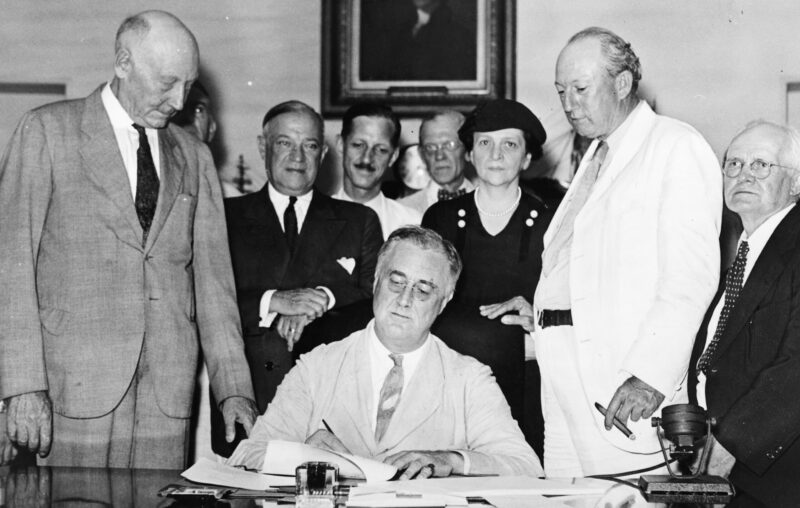
President Franklin D. Roosevelt signs the Social Security Act. 1935.
Donald Trump and Joe Biden began the campaign season by staying away from social security reform. Kamala Harris has only promised to strengthen it without providing details. Mr. Trump then proposed a truly bad idea and has refused to back down. That idea is the elimination of income taxes on social security benefits.
The richest retirees receive the most Social Security and thereby put the most pressure on an already unsustainable budget. Eliminating the income tax on benefits will result in them getting even more after-tax income, while significantly reducing income tax revenue at a time when it only takes our country 260 days to tack on another trillion to the national debt.
The Social Security program was too vulnerable to demographic bubbles from the very beginning and subsequent reforms have increasingly over-promised benefits thereby inviting our present budget insolvency. Voters are frustrated and losing confidence. They are looking for genuine leadership, not the “third rail of politics” policy détente we now have.
Harris and Trump now have an opportunity to provide such leadership. Each could promise to do one quick and simple thing as president to reduce the unfunded liability gap in Social Security funding. It’s easy to explain to voters, it will appeal to both younger and older voters, and it will especially appeal to those in the political middle who are looking for practical solutions rather than ideologically driven bumper sticker slogans. It would behoove both candidates to jump on this reform proposal first.
In 1972, an amendment was passed to protect Social Security beneficiaries from the effects of inflation. A mistake was made in the procedure for implementing the Cost of Living Adjustments indexing of benefits. This had the effect of over-accounting for the effects of inflation, leading to the prospect of benefit levels soaring out of control as inflation worsened in the 70s. In 1976, a Congressional panel led by a Harvard economist, William Hsiao, was convened in part to correct the error. The panel also recommended that the initial benefits calculation employ price indexing rather than wage indexing out of fear that the latter would produce an unsustainable budget. Unfortunately, wage indexing was chosen over price indexing.
This was a costly mistake, and we are still paying for it. As noted by Alex Durante in a recent Tax Foundation report,
Had price indexing [rather than wage indexing] been implemented under Hsiao’s proposal, Social Security would have run surpluses every year from 1982 to 2023, except for 2021. There would have been temporary shortfalls starting in 2024, but by 2044, Social Security would have been running surpluses again. Surpluses in Social Security could permit a reduction in the tax rate or allow some of the revenue raised from payroll taxes to support Medicare, which is also running large deficits.
While this was a terrible missed opportunity, the main lesson is still valid: wage indexing makes benefits grow too fast for program stability. Luckily, it is not too late to take Hsiao’s advice.
According to the Social Security Administration’s 2023 Trustee Report, adjusting the initial benefit calculation with a price index rather than a wage index will remove about 80 percent of the unfunded liability gap over the next 75 years, and that’s if instituted in 2029. The results are even more dramatic if we start sooner. That is major gain with minimal pain.
Most voters don’t realize that social security benefits have been, and continue to be, rising in inflation-adjusted terms due to wage indexing of the initial benefit calculation. This is because when the economy is growing, wages normally grow faster than prices (that’s what produces growing real personal income over time). As a result, since 1977, each new class of social security recipients lives a little larger than the ones before.
This is very foolish.
Young people are understandably worried about being cheated out of some of their Social Security benefits, and having the real value of the benefits they do receive eroded by inflation. They are not worried about not getting more from Social Security when they retire in real terms than their parents and grandparents did.
Most young people will happily support this reform because it provides strong assurance that they will get something they value greatly (a credible guarantee of not being impoverished in old age) in return for giving something up they don’t care about (getting more than their parents and grandparents did per dollar contributed).
This simple reform will not harm current retirees in any way and will produce a tremendous relief to those who are ready to retire and are already uneasy about their 401Ks, as well as younger workers who are simply looking for fair treatment.
The media and voters should force the candidates to explain why they won’t pledge, now, to drop wage indexing to stabilize Social Security going forward.

